The Liberty Bell

Recognizable for it's crack, the Liberty Bell remains significant today for its message of liberty.
NPS photo
The Liberty Bell bears a timeless message: "Proclaim Liberty Throughout All the Land Unto All the Inhabitants thereof"
Go beyond the iconic crack to learn how this State House bell was transformed into an extraordinary symbol. Abolitionists, women's suffrage advocates and Civil Rights leaders took inspiration from the inscription on this bell. Plan your visit to the Liberty Bell Center to allow time to view the exhibits, see the film, and gaze upon the famous cracked bell. No tickets are required and hours vary seasonally. 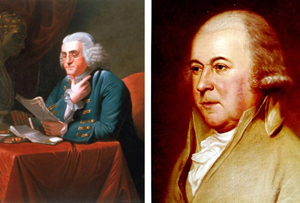
Benjamin Franklin
(left) wrote to Catherine Ray in 1755, "Adieu, the Bell rings, and I
must go among the Grave ones and talk Politicks." John Adams (right),
noted on July 8, 1776, "The bells rang all day and almost all night."
He never specified which bells in the city were ringing.
Benjamin Franklin (left) by David Rent Etter after Charles Willson Peale after David Martin, 1835. NPS image
John Adams (right) by Charles Willson Peale, c. 1791-1794, NPS image
From Signal to Symbol
The State House bell, now known as the Liberty Bell, rang in the
tower of the Pennsylvania State House. Today, we call that building Independence Hall.
Speaker of the Pennsylvania Assembly Isaac Norris first ordered a bell
for the bell tower in 1751 from the Whitechapel Foundry in London. That
bell cracked on the first test ring. Local metalworkers John Pass and
John Stow melted down that bell and cast a new one right here in
Philadelphia. It's this bell that would ring to call lawmakers to their
meetings and the townspeople together to hear the reading of the news.
It's not until the 1830's that the old State House bell would begin to
take on significance as a symbol of liberty. Listen to the story of the Liberty Bell in this audio podcast.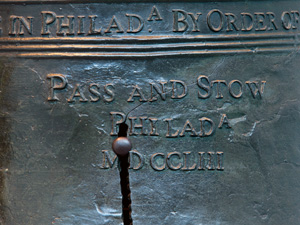
Look carefully for
the thin crack that begins in the "P" of "Philada". It continues up
through the word "AND" and then up through the word "Liberty" before
continuing on to the crown of the bell. That thin crack was too long to
repair.
NPS photo
The Crack
No one recorded when or why the Liberty Bell first cracked, but the
most likely explanation is that a narrow split developed in the early
1840's after nearly 90 years of hard use. In 1846, when the city decided
to repair the bell prior to George Washington's birthday holiday
(February 23), metal workers widened the thin crack to prevent its
farther spread and restore the tone of the bell using a technique called
"stop drilling". The wide "crack" in the Liberty Bell is actually the
repair job! Look carefully and you'll see over 40 drill bit marks in
that wide "crack". But, the repair was not successful. The Public Ledger
newspaper reported that the repair failed when another fissure
developed. This second crack, running from the abbreviation for
"Philadelphia" up through the word "Liberty", silenced the bell forever.
No one living today has heard the bell ring freely with its clapper,
but computer modeling provides some clues into the sound of the Liberty Bell.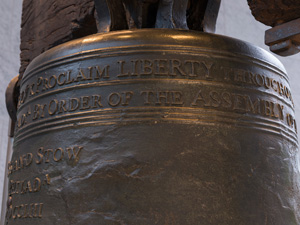
The inscription of
Liberty on the old State House bell, now known as the Liberty Bell, went
unnoticed during the Revolutionary War. After the war, abolitionists
seeking to end slavery in America were inspired by the bell's message.
NPS photo
The Inscription
The Liberty Bell's inscription is from Leviticus 25:10: "Proclaim
Liberty Throughout All the Land Unto All the Inhabitants thereof." This
Old Testament verse refers to the "Jubilee", or the instructions to the
Israelites to return property and free slaves every 50 years. Speaker of
the Pennsylvania Assembly Isaac Norris chose this inscription for the
State House bell in 1751, possibly to commemorate the 50th anniversary
of William Penn's 1701 Charter of Privileges which granted religious
liberties and political self-government to the people of Pennsylvania.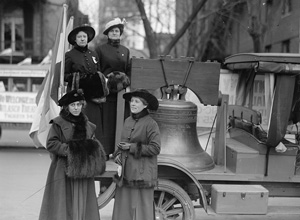
Suffragists
commissioned a replica of the Liberty Bell. Their "Justice Bell"
traveled across Pennsylvania in 1915 to encourage support for women's
voting rights legislation. It then sat chained in silence until the
passage of the 19th Amendment in 1920.
Courtesy, Kenneth Florey
The Meaning
The State House bell became a herald of liberty in the 19th century.
"Proclaim Liberty Throughout All the Land Unto All the Inhabitants
thereof," the bell's inscription, provided a rallying cry for
abolitionists wishing to end slavery. The Anti-Slavery Record,
an abolitionist publication, first referred to the bell as the Liberty
Bell in 1835, but that name was not widely adopted until years later.
Millions of Americans became familiar with the bell in popular culture
through George Lippard's 1847 fictional story "Ring, Grandfather, Ring",
when the bell came to symbolize pride in a new nation. Beginning in the
late 1800's, the Liberty Bell traveled across the country
for display at expositions and fairs, stopping in towns small and large
along the way. For a nation recovering from wounds of the Civil War,
the bell served to remind Americans of a time when they fought together
for independence. Movements from Women's Suffrage to Civil Rights
embraced the Liberty Bell for both protest and celebration. Now a
worldwide symbol, the bell's message of liberty remains just as relevant
and powerful today: "Proclaim Liberty Throughout All the Land Unto All
the Inhabitants thereof"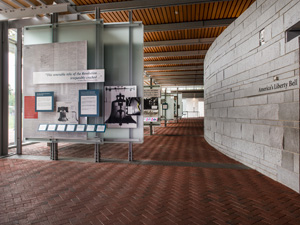
The exhibits in the
Liberty Bell Center include a fascinating array of information.
Unfortunately, there is still much we do not know about the Liberty
Bell, including exactly why and when it first cracked.
NPS photo
Bell Facts
The two lines of text around the top of the bell include the
inscription of liberty, and information about who ordered the bell
(Pennsylvania Assembly) and why (to go in their State House):Proclaim LIBERTY throughout all the Land unto all the Inhabitants thereof Lev. XXV X By Order of the ASSEMBLY of the Province of PENSYLVANIA [sic] for the State House in Philada The information on the face of the bell tells us who cast the bell (John Pass and John Stow), where (Philadelphia) and when (1753): Pass and Stow Philada MDCCLIII The bell weighed 2,080 lbs. at order. It is made of bronze. It's 70% copper, 25% tin and contains small amounts of lead, gold, arsenic, silver, and zinc. The bell's wooden yoke is American elm, but there is no proof that it is the original yoke for this bell. While there is evidence that the bell rang to mark the Stamp Act tax and its repeal, there is no evidence that the bell rang on July 4 or 8, 1776. 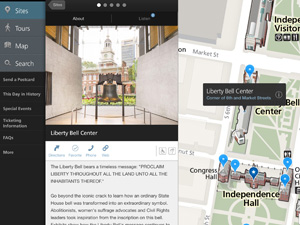
Additional
information about the Liberty Bell, including images and audio, is
available on the park's FREE app. Search "NPS Independence" in the App
Store or on Google Play. You can even "Ring the Liberty Bell" on the
app if you have an iOS device. Click on the image above to learn more.
NPS photo
Additional Information
Looking for Liberty Bell information in other languages? Information is available in a dozen languages.
Lesson plans about the Liberty Bell are available on the park's "For Teachers" page. "The Liberty Bell: From Obscurity to Icon", a Teaching with Historic Places lesson plan, is also available on the web.
There
are two other bells in the park today, in addition to the Liberty Bell.
The Centennial Bell, made for the nation's 100th birthday in 1876,
still rings every hour in the tower of Independence Hall. It weighs
13,000 lbs. - a thousand pounds for each original state. The Bicentennial Bell was a gift to the people of the United States from the people of Great Britain in 1976. That bell is currently in storage.
|
Did You Know?
 The exhibits in the Liberty Bell Center showcase the Liberty Bell’s
role as a symbol in the abolitionist movement, the fight for women’s
suffrage and the Civil Rights struggles of the 1960’s.
The exhibits in the Liberty Bell Center showcase the Liberty Bell’s
role as a symbol in the abolitionist movement, the fight for women’s
suffrage and the Civil Rights struggles of the 1960’s.



No comments:
Post a Comment